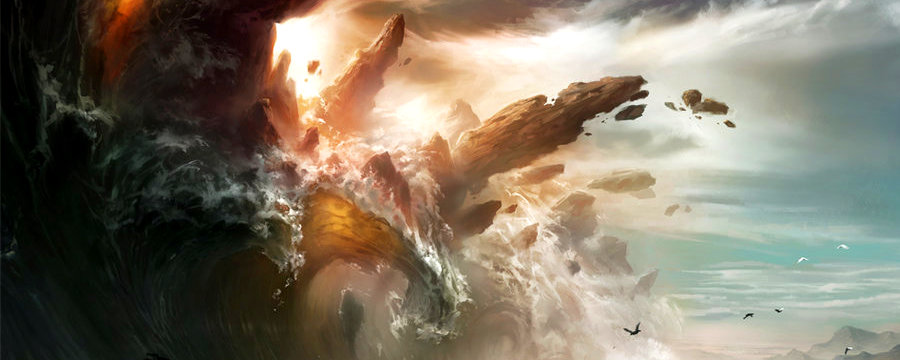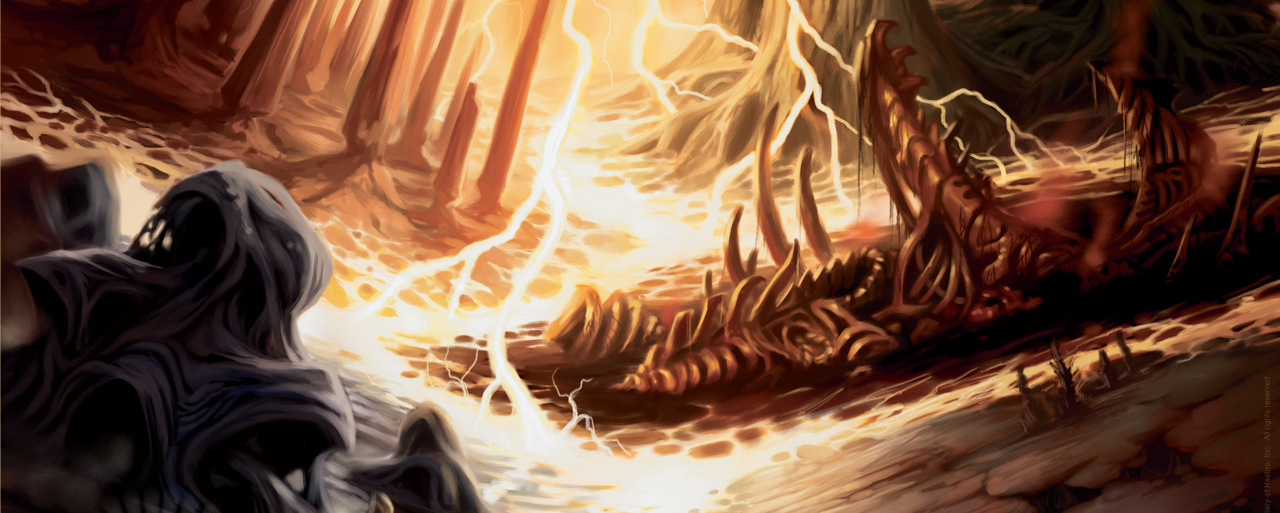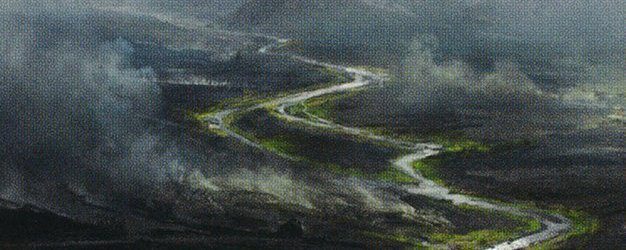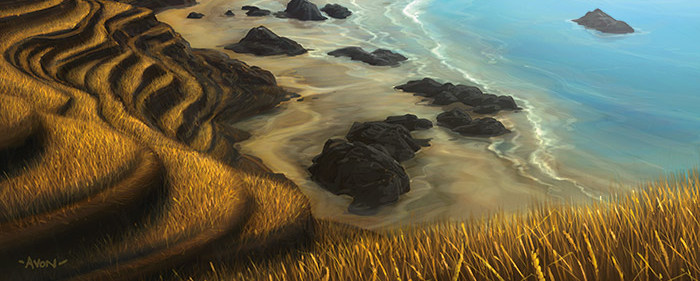
Manabase is often an underestimated component of deckbuilding and often, when we want to try a new archetype, we find the most common list run online and just copy it, making it spread more and more.
I don’t want to explain in details how to build a good manabase: it goes beyond my capability and it would require an enormous amount of work to write, but as I always do on this blog I will discuss a specific topic: the comparison between Gainlands, Ash Barrens and Poor-man’s fetches (Terramorphic Expanse and Evolving Wilds).
Editor note: Since Terramorphic Expanse and Evolving Wilds are the same, i will use the term fetches instead of any of the two, so i can say 6 fetches instead of a mix of 6 between Terramorphic Expanse and Evolving Wilds)
GAINLANDS VS FETCHES:

+ Shuffle Effect: fetches obviously synergize well with cantrips like Brainstorm (draw 3, shuffle away 2 bad cards) and Ponder (i get to choose which card to draw and shuffle the rest), but nullify the scry of Preordain.
+ Grows your graveyard: a big graveyard is essential in some decks, mainly to pay the delve cost and play a crucial fast and cheap Gurmag Angler or to reach threshold and utilize the full effect of Swirling Sandstorm;
+ Deck Thinning: ahhh, the noble art of thinning your deck! By using a land to fetch another land, we have reduced the number of cards in our deck, so now we have more chances to draw useful cards! It may seem like an insignificant detail (and to be honest, the chances of finding a spell before and after a fetch are almost the same in the majority of cases), but later in the game you can feel the consistency of hitting spell after using 3-4 fetchlands.
+ Gush: like I wrote in my last article, Gush requires you to play a lot of basic island or lands that can fetch them, it’s possible to play as much as 2 gainlands in some cases (UR Klin), but it’s a little, calculated risk and playing more than that is always bad and advised against.
+ It lets you play on curve with bouncelands: gainlands can be used with bouncelands to gain a little bit more life, but by doing so you are giving up the ability to play on curve since gainlands enter the battlefield tapped. By playing fetches, you can just fetch a basic turn 1, bounce it turn 2 and you will be able to cast a 3 drop on turn 3.
This can be relevant in decks that don’t need a lot of double colored lands in their manabase, and by using bouncelands and fetches they can have a better and more consistent / ready to go manabase.
A great example is Boros Bully, that usually runs a manabase like this one:
6 Plains
4 Boros Garrison
3 Wind-Scarred Crag
2 Evolving Wilds
– Only 1 color: even if it’s true that fetches can search for any of the 5 basic land types (no, please, don’t play wastes in pauper) the land that you get can tap for only one color. This could be really problematic when you are in a mana screw: let’s assume that a daring Delver U/x player decides to keep a starting hand with only one land (a lonely Evolving Wilds) hoping to find more with all the cantrips in his hand: he will surely fetch for an island turn 1, but even after a turn 2 and/or 3 cantrip he can only find spells and other islands! Without access to the black/red/white source that he desperately needs, he can’t cast non blue cards. In this case, a gainland would have been more helpful, letting him play more cards.
– 1 Less life: that little, insignificant extra life may seem useless, but sometime it’s the defining factor between winning and losing (more so if you can play multiple gainlands or bounce them and play them again).Just one single life point get us out of range of the classical Kiln Fiend combo (2 spell + Temur Battle Rage), 2 life forces Tireless Tribe to discard an extra card during combo turns, a bunch of life can give you an extra (hopefully decisive) turn against aggro and Burn: that little life gain is the spoonful of sugar that let us swallow the enter-the-battlefield-tapped medicine of gainlands.
In short, in Delver decks fetches and Ash Barrens are mandatory mainly due to the shuffle effect and Gush, while in more midrange and control decks like Rakdos Monarch or UB Alchemy a safer approach is preferred: gainlands give us access to both colors, they don’t shuffle our deck (Preordain thanks us) and give us that precious extra life.
ASH VS FETCH:

We already talked a lot about fetches, but what does Ash Barrens brings to the table?
+ instant access to a single color: having access to your off-color a turn earlier that fetches is usually crucial: in UR Delver to have the possibility to bolt against aggro, in UW Tribe so we can play our 1 drop earlier and put pressure on our opponent, in UB Angler because having a 5/5 on board as soon as possible is often the winning play.
Let’s examine a common scenario revolving around counterspell: with a bicolored deck like UR Delver you will often see yourself with an island and a mountain turn 3: Ash barren gives you the possibility to cycle for an island tapping the mountain, giving you the opportunity to keep mana open for a good Counterspell.
One last example with a different deck: in UW Familiar, Ash Barrens are a godsend when we have our familiars out in play. discounting our blue spells, we can just cycle for more islands with our now-useless white mana.
+ play during your opponent turn: Let’s start with an example: we’re playing UR Delver against Affinity, it’s game 1, I’m on the draw, we don’t have mountains and i’m not applying too much pressure while the Affinity player has got a Myr Enforcer on boards. We have two blue mana open and the relevant cards in our hand are Brainstorm, Counterspell and Ash Barrens.
We know that if Atog hits the field, we lose the game on the spot since our opponent can protect him by sacrificing some artifacts and our bolts will never be able to kill Mr. Smiley Face, but at the same time we want to draw some more cards and get a red mana source to use all the other cards in our hand.
We can also assume that a skilled Affinity player will never try to slam Atog on the board if he sees our 2 mana open and will try to play avoiding Spellstrutter Sprite too, in this situation we could Brainstorm followed by cycling Ash Barrens during our opponent end step to get new cards and fix our mana.
With a fetch instead of Ash Barrens, we couldn’t have done it during our opponent’s turn: Ash Barrens gave me the opportunity to keep my mana open and to better answer my opponent with the right play.
+ Synergy with Foil: Ash Barren’s landcycle is particularly relevant when we need an island to discard with Foil while playing UB Angler Delver; the deck usually play only 17 lands and statistically we can’t draw Gush to help us every game we play.
– Can’t keep a one-land-hand: How many times, while playing a mirror match with a midrange deck, we are sweating for a good starting hand to help us gain advantage to snowball and then we open a really good hand, maybe one or two cantrip to help filter our next draws, but with only one land: if the land we’re talking about is Ash Barrens, we can’t keep the hand and we’re forced to mulligan and start with only 6 cards in hand.
– Cycling is not free: while it’s true that Ash Barrens give you instant access to your off-color, it still cost a mana to cycle it while fetches are free; this is extremely important when lands are scarce and we need our primary color.
Let’s observe a situation with cantrips: it’s the second turn of the game, we are playing a delver deck and we have one or more cantrips in hand, one land in play and Ash Barrens in hand: we landcycle to get a mountain/swamp and since we don’t have any other land in hand, we play it. Now we can’t cantrip because we used our island to cycle and we missed an opportunity to fix our hand and spend our mana efficiently, a cardinal sin for any delver deck!
– It’s really bad when we’re low on lands: In a lot of blue decks, we can safely keep a starting hand with only one land with multiple cantrips, since they can help us find the next land drops. But what if we can only find Ash Barrens? We almost skip a turn: we’re a land behind and it may not matter that much if it’s the 4th or 5th land drop, but if it’s the second it may cost us the game!
A little note about bounceland interactions:
1.a) T1 Ash, T2 Tap for colorless, play bounceland, cycle Ash with the colorless i had in pool;
1.b) T1 Fetch and crack for basic, T2 cast a 1 drop and play a bounceland;
2.a) Midgame: tap a land that produces a color i’m not using to cycle with Ash and get a land that i need;
2.b) Midgame: play a fetch and fetch a color i need, but it enter the battlefield tapped.;
In the first situation, having the possibility to play a 1 drop on my second turn is essential to the gameplan of some decks like Boros Bully (and play Firebolt, Faithless Looting, Thraben Inspector or Sacred Cat); in the second situation Ash barren giving us access to untapped lands it’s better for decks like Familiar that want to play Familiars or maybe just recycle that blue/black mana they’re not using anymore.
You may have noticed that we don’t have a clear winner regarding Ash Barrens versus fetches if we think about delver or combo decks: they both have their own pros and cons.
Like in a lot of other different situations, when a card isn’t strictly better than the other, we play a mix of them to increase the chance of getting the right one at the right time and to get more options while playing..
PRACTICAL EXAMPLES

After this comparison, let’s now move on and analyze the manabase of some of the best archetypes right now!
UB Angler Delver:
8 Snow-Covered Island
2 Snow-Covered Swamp
6 Fetches
1 Ash Barrens
– 17 lands total: it’s a really low number for a bicolored delver deck, with delver decks we go down to 16 lands only with MonoU by building accordingly, it helps with flooding against midrange and delver mirrors.
– 14 lands that can tap for/fetch blue, our main color, on the first turn (in any deck it’s too risky to have this number under 13/14); we have cantrips to find other lands, but if we can’t play cantrips we’re screwed. The only exception is Elves that can play 12/13 lands, but only because Quirion Ranger and mana dorks let you play with only 1/2 lands each game.
– 9 lands that can tap for/fetch black, our off-color, on the first turn: in every deck with a lot of cantrips we play at minimum 8/9 off-color sources; playing 9 of them is the safest choice while only playing 7 means that we could play early game with only our primary color. Ponder and Preordain will help, but Brainstorm could be bad without any shuffling or scry effect (i.e. Brainstorm-lock).
-1 Ash Barrens: as we said before, we can do a lot of things with it but we’re scared of a seeing it as our only land so we only play one. This way we have access to 3 untapped black sources to cast Gurmag Angler before turn 4; playing 2 of them would be risky since if we find both of them in our first 10 cards we’re dead.
We love to call this one-of the icing on the cake: it’s inclusion is almost risk free while still enabling a lot of different plays. Who doesn’t love icing on their cake?
-2 Swamps: the first one is obviously needed for the splash, the second one is the same icing as before: it’s safe to play and gives us access to 2 black sources in the late game to make some plays like Gurmag Angler + Echoing Decay in a single turn, or double Echoing Decay against Affinity of UR Delver if one gets countered.
We can think about the inclusion of a third basic Swamp, but it’s not worth: the second one already provide us with stability and with one more off-color only source we increase the possibility of finding them instead of the blue that we still need so much.
– 7 Shuffle effect: essentials with our cantrips, we gain the ability to better manipulate our draws but we lose some explosiveness and the ability to play early game. In my opinion, in a deck with a decent cantrip package 6 is the least possible amount of shuffle effects needed to play, while the highest number is 9: that’s why 7 is a good compromise.
If we’re talking about the Elusive Spellfist version of the deck, our manabase changes since we need to be more aggressive, we’re also playing more cantrips since they keep fueling our blue monk’s prowless:
10 Island
2 Swamp
2 Ash Barrens
3 Fetches
The only thing I would change is the second Ash Barrens, too risky for us, it’s better to use a 4th fetch in its place.
UR Delver
9 Snow-Covered Island
2 Snow-Covered Mountain
4 Fetches
3 Ash Barrens
– 13 Blue mana sources available on your first turn (13/14 minimum)
– 16 Blue mana sources total (15/16 minimum)
– 9 Red mana sources (8/9 minimum)
-7 Shuffle effects (between 5 and 9 recommended)
Here i would like to point out the possible switch between the 3rd Ash Barrens and the 5th fetch: we still need two Ash Barrens for their instant fixing capabilities and we need it earlier than UB Delver, furthermore we have one more land in total to work with.
The 3rd Ash Barrens is again too much of a risk: we don’t want to see too many of them in the early game.
After reading Gavin Verhey’s wonderful articles on how many copies of a card we need to play, we know that we usually play 3 copies of a really strong card that we don’t really want to draw in multiple copies, 2 copies of cards that we still want to see occasionally, but we almost never want to draw it twice.
Ash Barrens isn’t an indispensable card that we want to see every game, it can hurt us more if we draw it twice than benefit if we draw it once, especially with limited mana available: with 2 Evolving Wilds we can play a slow but steady hand, but with 2 Ash Barrens we are forced to play suboptimally.
UW TRIBE
10 Snow-Covered Island
2 Snow-Covered Plains
4 Fetches
2 Ash Barrens
– We keep repeating ourselves, but we still play only 2 Ash Barrens for the same reasons: we need immediate access to white but don’t want to risk a dead/slow hand too much and we still need a lot of blue.
– We strongly disagree with the second Plains because here the price of having one more non-island is too much: the deck needs to combo out with Inside Out + protection (and maybe + something to make our tribe unblockable), we can use one Plains to pay for the colorless part of Inside Out’s cost, but the second Plains is worthless (except rare cases like Apostle’s Blessing and Ajani’s Presence), we need blue mana to cast Dispel and Circular Logic.
This deck, loved pet deck of mine, can’t afford to draw the second Plains when it needs an Island to protect our combo or cantrip: the inclusion of this extra basic land is downright dangerous, assuming that we aren’t playing in an aggro metagame..
-6 Shuffle effects (between 5 and 9 recommended): Tribe is a combo deck, so it needs to find its combo pieces, accordingly we need to dig deeper in our library than a Delver deck, that’s why we’d like to play more shuffle effects to better supplement our cantrips. This have the added benefit of increasing our potential white sources to 9, enhanching our chances to find a Plains before 4th turn and helping in a lot of matchups.
That said, this is in my opinion the more solid and reliable manabase to play in the current metagame after testing it for about a year:
9 Snow-Covered Islands
1 Snow-Covered Plains
6 fetches
2 Ash Barrens
CONCLUSION

I really hope that you liked this write-up, this is the kind of articles that we want to put here, with some more on the state of the metagame and on the banlist.
You will always find very specific discussions with practical examples that want to confirm or explain what we can find online, addressing arguments like manabases little by little with the purpose of leaving hints that our readers can think about.
Please, let us know what do you think about our articles and whatever can help us be better.
We just started out, so any feedback on contents, the way the article is structured and the translation will be really helpful for us to learn and grow.
See you all next time!
Original article written by Crila Peoty (Bragioto Pietro) HERE
Translated by: Gabriele “gabky” Pastori


